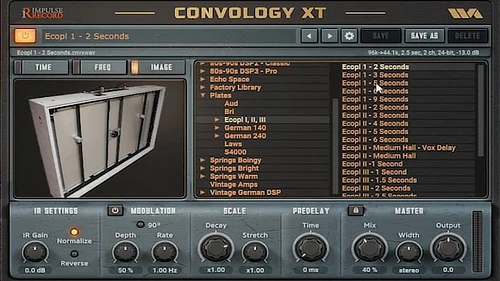The Lexicon 480L is engineered for the emerging all – digital production environment. Digital audio places strict requirements on every link in the signal chain, and the Lexicon 480L meets those requirements.
With its unique 18 bit linear A/D and D/A converters, the Lexicon 480L produces a dynamic range of 98 dB in the wet signal path. It is probably the only effects system available that doesn’t raise the noise floor of a digital master. And the PCM 1610/1630 compatible digital I/O interface lets you add true stereo ambience and effects without leaving the digital domain.
The Lexicon 480L doesn’t just sound better – sheer computational power allows it to perform multiple audio tasks at the same time. And what tasks! In the current glut of throwaway digital devices with ever-cheaper versions of the same sounds, the Lexicon 480L offers remarkable new effects and reverb sounds.
Its innovative reverb algorithms reflect a more accurate and natural model of the acoustic and psychoacoustic phenomena of reverb and ambience. Put the Lexicon 480L up against any other reverberator – you’ll be amazed at the difference.
Reverb is only part of the story. The Lexicon 480L produces astonishing affects you haven’t even begun to dream about yet. And its sampling programs offer a variety of useful and unique features.
The present software is powerful and comprehensive, a dramatic step forward in digital signal processing technology. Yet it hasn’t explored the limit of the Lexicon 480L’s architecture, which is itself configured for future hardware expansion.
If you are familiar with the venerable Lexicon 224XL, you’ll feel right at home with the LARC used to control the Lexicon 480L. However, there are enough differences in the way the two units operate that we strongly suggest that you read the manual as soon as possible.
In it, you’ll discover that the Lexicon 480L’s two high speed processors can operate in a variety of configurations. Samples can be processed with reverb or effects, all in the digital domain.
Two Lexicon 480Ls can be connected through their digital I/O ports for even wider creative horizons. The Lexicon 480L can even be connected to a 224XL and both units operated from a single LARC.
In addition to its analog inputs and outputs, the Lexicon 480L is equipped with a PCM digital I/O connector. One application for digital I/O is processing material from a PCM 1610 or compatible unit. The WET/DRY MIX control in the reverb and effects programs makes it possible for the 480L to add signal processing to a stereo mix; without ever leaving the digital domain.
Another application for digital I/O is to cascade two or more Lexicon 480Ls together to create complex effects, again, without leaving the digital domain. In this application the first Lexicon 480L in the chain supplies word clock for the other units. Set the first unit for internal 48 kHz mode, and the second and subsequent units for external 48 kHz mode.
Drive levels and data format are compatible with the PCM 1610. Sync, pre-emphasis and flag bits are derived from the input bit stream. The 480L may also be interfaced with the Sony 3324 digital multitrack recorder. The 3324 uses a balanced 1610 format, but this is easily accommodated by grounding the low side of each signal line at the 480L interface connector.












